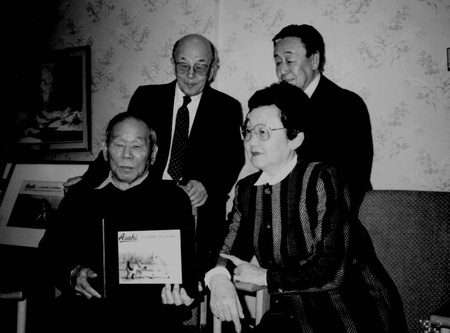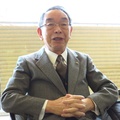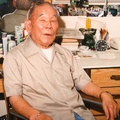As I was reading Yobun Shima’s “Family History of Kenichi Doi, Vancouver Asahi pitcher in 1926” submitted to the series “More Than a Game: Nikkei Sports,” the past 30 years of my life with the Asahi flashed through my mind. This is my memoir of the Asahi.
*****
My journey with the Asahi started with Pat Adachi’s book ASAHI: A Legend in Baseball which was published in 1992. I remember that Pat came to the editorial office of Nikkei Voice one day and handed me a box full of cakes, saying “I have a little favor to ask.” She then added, “This is for your kids by the way.” ”That’s how I got involved in the editing of the book, and I did the Japanese translation and typesetting. Her father, Iwaichi Kawashiri, was a man who dedicated his life to the Nikkei community as an Issei leader.
On August 28, 1992, on the day of the book launch party, I saw Ken Kutsukake (catcher) introducing the 11 legendary former players one by one on the stage at the Japanese Canadian Cultural Centre. It was such a delightful sight and I remember sharing the moment with Pat, clasping each other’s hands in joy. It was at that moment that the Asahi and all of its players threw an invisible net at Canada and Japan. And Shima and I are their “descendants,” caught in the net and pulled in by its force.

The team’s manager, Eddie Kitagawa, often said, “We the Nisei were just playing baseball for fun.” His word choice in the Nisei language here (he used the verb asobu which means “play” in Japanese, but this verb is not collocated with sports in Japanese), while the Japanese people would say purei (as in English), was striking to me. Indeed, during the 1920s when Kenichi Doi was active in the front lines, I think that the Nisei were simply having fun “playing” baseball.
In 1921, the Asahi went on the road in Japan and played 22 games against college and junior high school teams; the result was “11 wins, 10 losses, and 1 draw.”One of the players on the team at the time, the pitcher Tokikazu Tanaka (Hojo) went all the way to Fukuoka after the team finished the games and married Kizue whom he was exchanging letters with. It was such a relaxing atmosphere. Hojo worked as a principal at a Japanese language school before the war and left a journal of high importance as the leader at the Angler POW Camp during the war.
It was around the time when the team won the Terminal League for the second time in 1930 that baseball no longer meant something they could simply “play.” Immigrant communities are highly sensitive to the tension between their home countries and the world, and they react accordingly. Since the Mukden Incident in 1931, the Nikkei community had rapidly strengthened its nationalism. Games became stormy, like players were in a “battlefield,” which is a direct quote from the catcher Kutsukake. In one game, the three major players on the Asahi were hit by pitch, and the fans stormed into the field. When the Asahi won, the team’s fans started to raise the roof as if it was a victory of Japanese troops. Some players told me that they were embarrassed because a teacher at a Japanese language school Tsutae Sato would shout three cheers of banzai whenever the team scored.
The players worked very hard. The team kept winning league competitions, and they once even played in a higher ranked senior league, as many teams wanted to play against the popular Asahi in hope of earning good performance income. But the Asahi no longer had its shine. In fact, the shortstop Roy Yamamura was probably the only one skillful enough as a semi-professional.
On the other hand, it wasn’t just the boys that the team attracted. Hatsumi Hosoi, a Nisei who lives in Kobe once told me that she was a big fan of the center fielder Frank Shiraishi and that she used to passionately stare at his back from the outfield bleachers.
In 1992, Norio Goto who used to work at Chubu-Nippon Broadcasting as a sportscaster for live broadcasts of baseball took a trip to Canada with his wife Kyoko. On a bus running around Vancouver, they heard someone speaking Japanese, and the wife heard the words, “I used to play with baseball on this field when I was young.” And this is how they met Kaye Kaminishi. For the following 8 years, Goto thoroughly worked on his research of the team and published The story of Vancouver Asahi in 2010.
This “net” that the Asahi had thrown had actually reached his wife. It turned out that his wife Kyoko’s mother’s best friend Takeki Chiba was married to Kinpei Goto – who was on the stowaway ship Suian Maru in 1906. How far does this net of history expand?
There is Shozo Miyanishi who lived on Pape Avenue, two blocks away from where I lived in Toronto. In 1935, when the Tokyo Kyojin team came to Vancouver, he went to watch a game with his friend and Asahi’s pitcher Tameo (Ken) Noda, and what he captured in a photo he took when a tall man appeared right in front of him was the pitcher Victor Starffin from the Asahikawa middle school. At age 18, he was still a rookie, and a flamethrower but with poor control. Starffin soon became a great pitcher, but he was kept in custody in Karuizawa during the war as an enemy alien. He no longer was a flamethrower after the war and died in a mysterious car accident, hitting a train. Tameo Noda, on the other hand, was sent to war by Japan and died on the battlefront in China. For the two Nisei players, Starffin and Noda, when they were “playing” baseball was probably the only time and place in life where they could be who they were. (“Sporting Niseis of 1930s–Posing on Camera” published on March 6, 2020)
And there is a Nisei in Toronto named Doi Manabu who was eager to have a monument built in a graveyard in his hometown Cumberland. But apparently I missed the story of Kenichi Doi. Suyama Tokugi had heard the name of the pitcher Ken Nakanishi who was an active player around 1933. And when I visited the Japanese Overseas Migration Museum in Yokohama in 2018, one of the volunteer guides surprised me with a casual reveal of his identity – “Oh, Ken is my uncle.”
And that guide Teruo Nakanishi’s grandfather Kanekichi Nakanishi was one of the people from Hiroshima who immigrated to Cumberland in 1891. Teruo had studied his family history for seven years and his findings included the fact that his uncle Ken went to war as a Japanese soldier and that he was writing reports on war situations for the Japanese paper Tairiku Nippo. Just like Shima, Nakanishi’s life was also caught in the net of the Asahi team.
History is like a rope of invisible strings braided together. Our life is a product of individually lived histories braided together. Writer Joy Kogawa, one of the founders of Nikkei Voice, which was first published in 1987, describes it as “Everything is connected.”
Historian Croce said, “All history is contemporary history.” This means that my existence is connected to all human beings through the memories engraved in my DNA and that how the connection looks and is perceived is always changing. It’s because I, the one who perceives history is always changing along with society.
Yobun Shima’s research on his family history was his attempt to get the players of the Asahi team from 100 years ago out of its legendary tale, find a full name of each member and make them revive in contemporary history. He found the picture of his uncle Shoichi, but it might have been Shoichi who called to be found – Please find me! I’m here.
On a last note, I’d like to mention that during the 1910s, Shoichi Shima in Vancouver Asahi must have played against Victoria Nippons too. And the center fielder George Tatsuo Nagano must have been there. The one standing on the very left in this photo of the Nippons is George. He is the eldest son of Manzo Nagano who is said to be the first Japanese-Canadian immigrant. I never had a chance to meet George but met his eldest daughter Jun Morisaku (Manzo’s first grandchild) in Toronto. We have been exchanging letters for over a decade, and I have written her profile story.
The tie she gave me, which she said was a leftover from when she was working at a sewing plant in Los Angeles, has now become a precious piece of treasure that gives me a connection to Manzo Nagano.
Now, the question is, what will I leave to the next generation as my cultural legacy?
© 2021 Yusuke Tanaka





